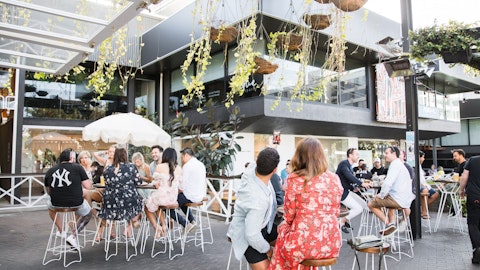Marcelo Rabach: Okay. Thank you. No, absolutely not. We are very pleased with how the year is developing. We’ve seen strong sales growth in the first half in all three divisions, particularly in Brazil with 2.5x our systemwide comparable sales on top of inflation. And importantly, we continue to see solid sales trends in the third quarter as well, with systemwide comparable sales growing well above inflation in all the three divisions. I think that the McDonald’s brand in our region in Brazil and the rest of the markets is now positioned in a way that it should perform well in good macroeconomic times and in more challenging environments. Unfortunately, the structural advantages of our freestanding footprint, freestanding restaurants, the strong performance, our growth of Three D’s, and a prudent competitive pricing strategy are driving sustained sales growth all across the region, even in the current environment.
So we still see – we are very confident on our ability to continue to grow sales above inflation and having growth in our profitability coming from volumes, additional traffic and additional average check.
Daniel Schleiniger: Perfect. Thanks Marcelo. And Thiago’s last question. This will be for you, Mariano. If we can have any quantification on how the Argentine peso devaluation could impact our EBITDA, and he says gracias.
Mariano Tannenbaum: Perfect. Thanks, Thiago, for the question. Devaluation of the Argentine peso reduces the country’s U.S. dollar contribution to consolidated revenue and EBITDA, but the impact on EBITDA as well is partially offset by a reduction of corporate G&A expenses also denominated in Argentine pesos. With what we know today with the announcement made so far, this week’s devaluation of the Argentine peso will not significantly impact consolidated EBITDA in the second half of the year from a pure FX perspective. Having said that, we need to be prudent to see how these measures will affect consumption in the remaining part of the year. But from a pure FX and devaluation perspective that, that was the question, we are not seeing a significant impact on consolidated EBITDA.
Daniel Schleiniger: Great. Thanks, Mariano. And by the way, before I continue, I just wanted to recognize Jeronimo de Guzman also submitted a couple of questions. Jeronimo, I think we’ve answered your questions on Brazil and SLAD, but if not, please feel free to resubmit. We have the next question from [indiscernible] from JPMorgan. And she asked what’s the level of cash we feel comfortable operating. Again, back to you, Mariano.
Mariano Tannenbaum: Perfect. Thanks, [indiscernible] for the question. First, we ended June with cash and equivalents plus short-term investments in our balance sheet of a total of $222 million with no material short-term debt with a very healthy net leverage ratio. So we are very confident with that figure. To operate in our markets in the 20 markets, we estimate that between $60 million and $80 million in cash is more than enough to run the business from a working capital perspective.
Daniel Schleiniger: Okay. Well, since you touched on working capital, Mariano, it’s actually a perfect timing because the next question is from again, from Thiago Bortoluci at Goldman Sachs. If I may, one more, could you please give us more color on your working capital dynamics. The consumption of suppliers in the first quarter from all lines in the second quarter, should we expect it to be net in the full year?
Mariano Tannenbaum: Perfect. Well, first, I would like to clarify that if we compare last year with 2022. In 2023, the first half, we have different dynamics going on because both figures are comparing, one, the 2022 with December 2021 numbers this year is comparing with December ’22 figures. So what happened last year is that we were increasing our cash flow because we were comparing to December ’21 when the business was still normalizing coming out of the pandemic. So the first half of last year activity was much higher than prior year-end, and that’s what is why we saw the increase in cash flow in 2022. So significant increases in sales, they generate more working capital. So in 2023, what we are seeing is that we’re still generating more sales.
And also, we have made some payments to suppliers in June 2023 that allowed us to lock in better prices from some ingredients and better manage our gross margin that you can see in our gross margin results, but at the same time, consumed a bit more cash than normal in the period as well. For the rest of the year and with more activity, what we will see is an increase in cash flow for the second half of the year that will more than compensate from an operational cash flow perspective, the decrease that you saw in the first half of this year.
Daniel Schleiniger: Great. The next questions come from Ulises Argote at JPMorgan. As I mentioned, he had a couple of questions that I think we’ve already answered. So he says, congrats on the results. Thanks for the space for the questions. And the ones from this side, one is the tax rate, which I think Mariano has already answered in detail, the second has to do with the divestment of restaurants and so on. And is this a specific situation or there is something ongoing? I think Marcelo left to that as a specific situation. And the third question he has is focus on remodeling remains, what’s the trend for sales lifts on the remodeled restaurants and I’ll give that one to you Marcelo.
Marcelo Rabach: Excellent. And thank you, Ulises for the question. Yes, we said that we are planning to modernize to the EOTF format approximately 250 restaurants this year. And we are doing this because we are experiencing a very good impact on these investments in terms of the sales lifts that they generate. Since the very beginning when we started with this initiative, four or five years ago in the south part of the region, we saw that every single restaurant that was converted to EOTF had a sales lift of mid-to high single digits when compared with the other restaurants in the market. So we continue to experience those kind of figures, for example, in countries like Mexico, where we still have a lot of room to deploy the EOTF format.
And we are very pleased with this because this will be a huge source of growth going forward because we still have approximately 50% of our restaurant base to be converted to be modernized and converted to EOTF. So we will have that boost in sales coming from those investments, coming from those restaurants, which is very good to sustain the kind of results we are delivering in recent quarters.
Daniel Schleiniger: Great. Thanks, Marcelo. We have a couple of questions from Christopher [indiscernible]. The first one is related to profitability margin, but the second one has to do with target share price. Christopher, we’re not going to comment on target shares. I think that’s something you can get from the sell side. With respect to your other question, what do we expect in terms of profitability margins to be in the future with the opening of the new restaurants. And I’ll give that one to you, Mariano.
Mariano Tannenbaum: Perfect. And thanks, Chris, for the question. In terms of general margin outlook, our plan is clear, and we are delivering. We remain focused on driving top line with sustainable volume growth in all channels to deliver EBITDA growth in U.S. dollars with a healthy margin profile. And we are delivering that in this quarter with a more than 20% increase in our EBITDA in dollar terms. And you can see the results in second quarter figures. We are seeing improvements in all restaurant level expense items as a percentage of sales with the exception of royalties. In terms of openings, we are seeing a very good ROI on the openings. As Marcelo mentioned, we are opening mainly for standings, and we are seeing very attractive ROI on those openings.




